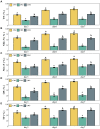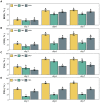Composition of the microbial community in surface flow-constructed wetlands for wastewater treatment
- PMID: 39101038
- PMCID: PMC11296210
- DOI: 10.3389/fmicb.2024.1421094
Composition of the microbial community in surface flow-constructed wetlands for wastewater treatment
Abstract
Traditionally constructed wetlands face significant limitations in treating tailwater from wastewater treatment plants, especially those associated with sugar mills. However, the advent of novel modified surface flow constructed wetlands offer a promising solution. This study aimed to assess the microbial community composition and compare the efficiencies of contaminant removal across different treatment wetlands: CW1 (Brick rubble, lignite, and Lemna minor L.), CW2 (Brick rubble and lignite), and CW3 (Lemna minor L.). The study also examined the impact of substrate and vegetation on the wetland systems. For a hydraulic retention time of 7 days, CW1 successfully removed more pollutants than CW2 and CW3. CW1 demonstrated removal rates of 72.19% for biochemical oxygen demand (BOD), 74.82% for chemical oxygen demand (COD), 79.62% for NH4 +-N, 77.84% for NO3 --N, 87.73% for ortho phosphorous (OP), 78% for total dissolved solids (TDS), 74.1% for total nitrogen (TN), 81.07% for total phosphorous (TP), and 72.90% for total suspended solids (TSS). Furthermore, high-throughput sequencing analysis of the 16S rRNA gene revealed that CW1 exhibited elevated Chao1, Shannon, and Simpson indices, with values of 1324.46, 8.8172, and 0.9941, respectively. The most common bacterial species in the wetland system were Proteobacteria, Spirochaetota, Bacteroidota, Desulfobacterota, and Chloroflexi. The denitrifying bacterial class Rhodobacteriaceae also had the highest content ratio within the wetland system. These results confirm that CW1 significantly improves the performance of water filtration. Therefore, this research provides valuable insights for wastewater treatment facilities aiming to incorporate surface flow-constructed wetland tailwater enhancement initiatives.
Keywords: constructed wetland; crushed bricks; lignite; microbial community; pollutant removal.
Copyright © 2024 Ali, Min, Yu, Kooch, Marnn and Ahmed.
Conflict of interest statement
The authors declare that the research was conducted in the absence of any commercial or financial relationships that could be construed as a potential conflict of interest.
Figures




References
-
- Adhikari U., Harrigan T., Reinhold D. M. (2015). Use of duckweed-based constructed wetlands for nutrient recovery and pollutant reduction from dairy wastewater. Ecol. Eng. 78, 6–14. doi: 10.1016/j.ecoleng.2014.05.024 - DOI
-
- Al Ali A. A., Naddeo V., Hasan S. W., Yousef A. F. (2020). Correlation between bacterial community structure and performance efficiency of a full-scale wastewater treatment plant. J. Water Process Eng. 37:101472. doi: 10.1016/j.jwpe.2020.101472 - DOI
LinkOut - more resources
Full Text Sources
Miscellaneous

